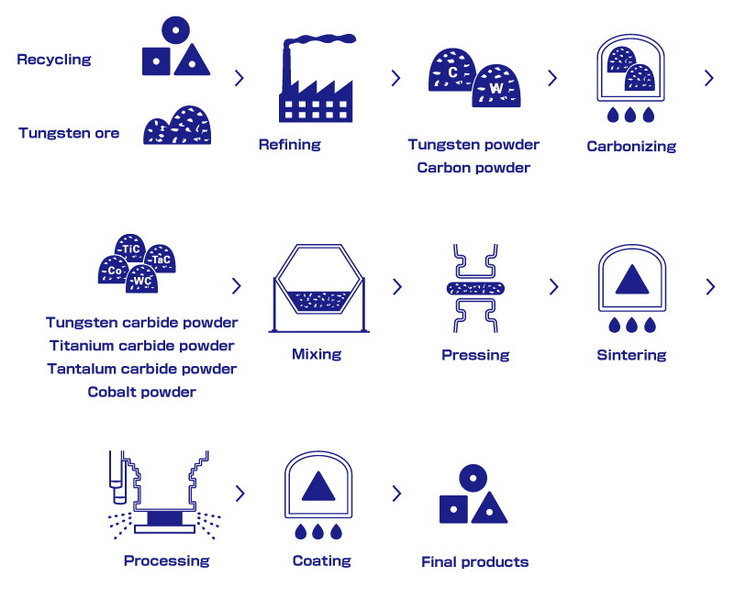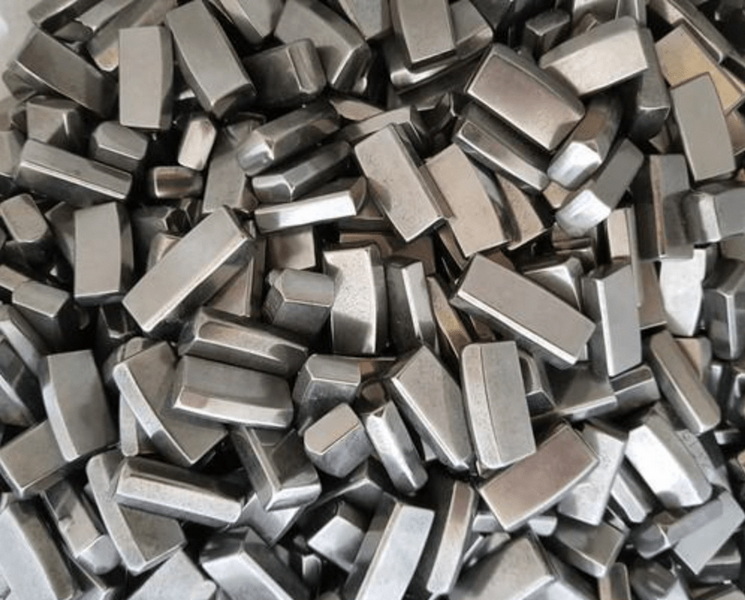Content Menu
● What are Tungsten Carbide Insert Tips?
● Manufacturing Process of Tungsten Carbide Insert Tips
>> 1. Powder Preparation
>> 2. Mixing
>> 3. Shaping
>> 4. Sintering
>> 5. Finishing
● Factors Affecting the Quality of Tungsten Carbide Insert Tips
● Applications of Tungsten Carbide Insert Tips
● Advantages of Using Tungsten Carbide Insert Tips
● Conclusion
● FAQ
>> 1. What is tungsten carbide?
>> 2. What are the main steps in manufacturing tungsten carbide insert tips?
>> 3. Why is sintering an important step in the manufacturing process?
>> 4. What are some common applications of tungsten carbide insert tips?
>> 5. What factors affect the quality of tungsten carbide insert tips?
● Citations:
Tungsten carbide insert tips are essential components in modern manufacturing, prized for their exceptional hardness, heat resistance, and wear resistance[4]. These properties make them ideal for use in cutting tools for drilling, boring, shaping, and forming metal workpieces[4]. Carbide inserts are widely used across various industries, including aerospace, automotive, and electronics, for machining a variety of materials[3][4]. Understanding the manufacturing process of these insert tips is crucial for machinists and manufacturers to optimize their tooling and processes.

What are Tungsten Carbide Insert Tips?
Tungsten carbide, also known as cemented carbide, is a composite material consisting of tungsten carbide particles and a metallic binder, typically cobalt[4]. The hard tungsten carbide grains provide the insert with its hardness, while the cobalt acts as a binder, holding the materials together[4]. The combination results in a material that can withstand high temperatures and extreme wear, making it suitable for demanding machining operations[4].
Tungsten carbide insert tips are the cutting edges of many modern cutting tools[4]. They are replaceable and come in various shapes and sizes to fit different toolholders and machining applications[4]. These inserts are used in operations such as boring, construction, cutoff and parting, drilling, grooving, hobbing, milling, mining, sawing, shearing and cutting, tapping, threading, turning, and brake rotor turning[4].
Manufacturing Process of Tungsten Carbide Insert Tips
The manufacturing process of tungsten carbide insert tips involves several key stages, including powder preparation, mixing, shaping, sintering, and finishing[1].
1. Powder Preparation
The first step in manufacturing tungsten carbide inserts is preparing the tungsten carbide powder[1]. This involves combining tungsten and carbon, which are then ground into a fine powder[1]. The quality of this powder significantly affects the properties of the final product[1].
2. Mixing
The tungsten carbide powder is mixed with a metallic binder, usually cobalt, and other additives in a ball mill or other mixing equipment[1]. This ensures a uniform distribution of the binder and additives throughout the powder[1]. The ratio of cobalt to tungsten carbide influences the insert's hardness; a higher cobalt content results in a softer insert[4].
3. Shaping
After mixing, the homogeneous mixture is ready for shaping[1]. Several shaping methods can be used, including pressing, extrusion, or injection molding[1]. These methods form the cemented carbide inserts into the desired shape and size[1].
4. Sintering
Sintering is a crucial step in the manufacturing process, transforming the shaped inserts into a solid and dense material[1]. The inserts are placed in a high-temperature furnace and heated to a temperature just below the melting point of the metallic binder[1]. This causes the binder to melt and bond the tungsten carbide particles together, creating a solid structure[1].
5. Finishing
After sintering, the inserts may undergo additional finishing processes to achieve the final dimensions and surface finish[1]. These processes can include grinding, lapping, and coating[8]. Coatings, such as titanium nitride (TiN) or aluminum oxide (Al2O3), can be applied to improve the insert's wear resistance and performance[8].

Factors Affecting the Quality of Tungsten Carbide Insert Tips
Several factors can affect the quality and performance of tungsten carbide insert tips:
- Grain Size: Smaller tungsten carbide grains result in harder, more wear-resistant inserts[4]. Larger grains result in softer inserts[4].
- Cobalt Content: The amount of cobalt binder affects the insert's toughness and hardness. Higher cobalt content increases toughness but reduces hardness[4].
- Porosity: Low porosity is essential for high strength and wear resistance. High porosity can lead to premature failure[4].
- Coating Quality: The type and quality of coating can significantly improve wear resistance, reduce friction, and increase tool life[8].
Applications of Tungsten Carbide Insert Tips
Tungsten carbide insert tips are used in a wide range of machining applications across various industries[4]:
- Metalworking: Cutting tools for turning, milling, drilling, and threading[4].
- Mining: Drill bits for rock drilling and cutting[4].
- Construction: Cutting tools for asphalt and concrete[4].
- Automotive: Machining engine components, brake rotors, and other parts[4].
- Aerospace: Machining high-strength alloys for aircraft components[4].
Advantages of Using Tungsten Carbide Insert Tips
There are several advantages to using tungsten carbide insert tips in machining operations:
- High Hardness: Tungsten carbide is exceptionally hard, allowing it to cut through hard materials at high speeds[4].
- Wear Resistance: Tungsten carbide inserts can withstand abrasive wear, extending tool life[4].
- Heat Resistance: Tungsten carbide maintains its hardness and strength at high temperatures[4].
- Versatility: Tungsten carbide inserts are available in various shapes and sizes for different applications[4].
- Replaceability: When the cutting edge wears out, the insert can be easily replaced, reducing downtime and tooling costs[4].
Conclusion
The manufacturing of tungsten carbide insert tips is a complex process involving powder preparation, mixing, shaping, sintering, and finishing[1]. The quality of the final product depends on factors such as grain size, cobalt content, porosity, and coating quality[4][8]. Tungsten carbide insert tips offer numerous advantages, including high hardness, wear resistance, and heat resistance, making them essential in modern machining operations[4]. By understanding the manufacturing process and the factors that affect the quality of these inserts, manufacturers and machinists can optimize their tooling and processes to achieve superior results.

FAQ
1. What is tungsten carbide?
Tungsten carbide, also known as cemented carbide, is a composite material consisting of tungsten carbide particles and a metallic binder, typically cobalt[4]. It is known for its high hardness, wear resistance, and heat resistance[4].
2. What are the main steps in manufacturing tungsten carbide insert tips?
The main steps include powder preparation, mixing, shaping, sintering, and finishing[1].
3. Why is sintering an important step in the manufacturing process?
Sintering transforms the shaped inserts into a solid and dense material by heating them to a temperature just below the melting point of the metallic binder, causing the binder to melt and bond the tungsten carbide particles together[1].
4. What are some common applications of tungsten carbide insert tips?
They are used in metalworking, mining, construction, automotive, and aerospace industries for cutting, drilling, and shaping various materials[4].
5. What factors affect the quality of tungsten carbide insert tips?
Factors include grain size, cobalt content, porosity, and coating quality[4][8].
Citations:
[1] https://www.zgcccarbide.com/news/The-Manufacturing-Process-of-Cemented-Carbide-Inserts:-A-Comprehensive-Guide-39.html
[2] https://www.alamy.com/stock-photo/tungsten-carbide.html
[3] https://plaza.rakuten.co.jp/rockdrillbits/diary/202311080000/
[4] https://www.hjcarbide.com/new/How-Tungsten-Carbide-Inserts-are-made.html
[5] https://www.alamy.com/stock-photo/carbide-insert.html
[6] https://www.youtube.com/watch?v=0QrynzJ_lZ4
[7] https://www.shutterstock.com/search/carbide-tip
[8] https://wencerl.com/how-to-make-carbide-inserts-a-comprehensive-guide/
















